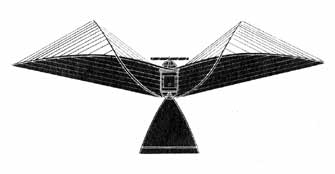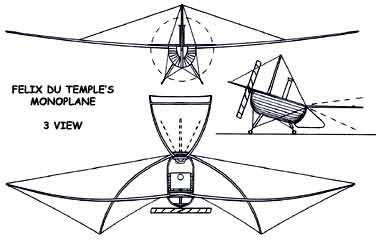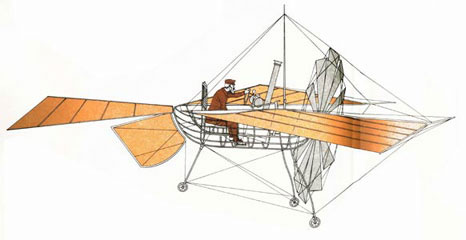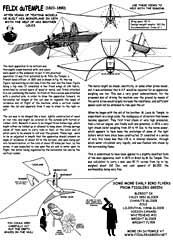
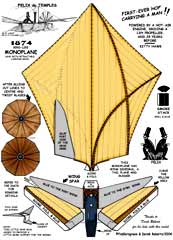
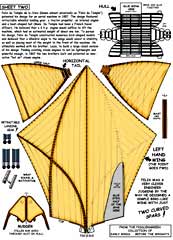
Felix du Temple Early Flying Machine Monoplane
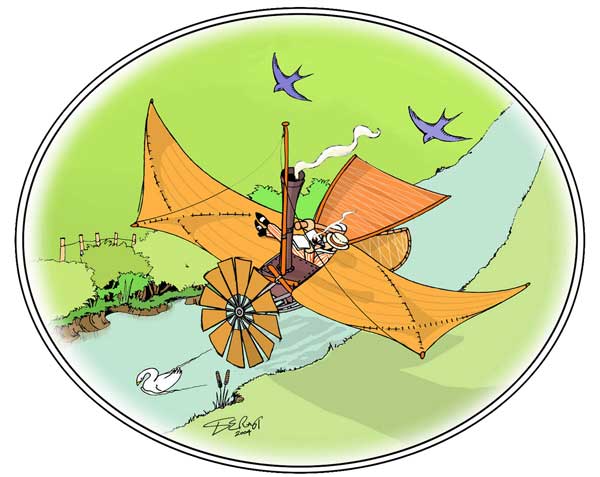
This original artwork by Derek Roberts is available in much higher quality (suitable for framing), on the Full Collection DVD.
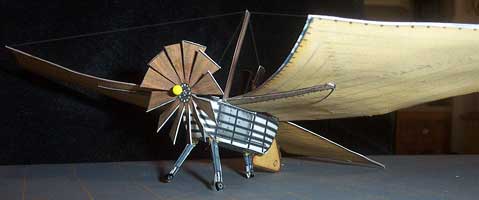
By 1874 the du Temple had constructed a large finely-built monoplane, at Brest, France, with a wing span of some 40 feet and a weight (minus the operator) of only about 160 pounds.
At least one attempt to actually fly the machine was made and it is generally agreed that after gaining speed down an incline, the flying machine lifted off for a short time and then returned to the ground, with both machine and operator uninjured.
The duTemple Monoplane comes in a folder of two sizes plus great instructions. The larger version has a span of 14" !!
I love what you guys are doing with these Early Birds. Not only do we get a model but another fascinating lesson in Aviation History..Keep up the good work friends.... Bob G
I built your duTemple monoplane (as I did with all the other Early Flying Machines) and hung them from the ceiling in our bedroom. They're so cute and grounding and fun to watch as I get ready to start my day at NASA.. Robt M
Felix du Temple's Flying Machine
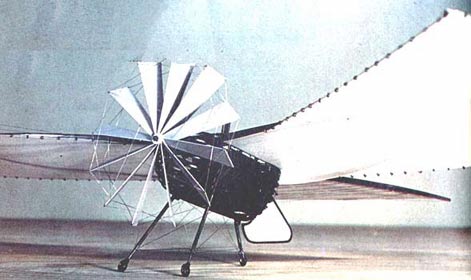
Felix du Temple de la Croix (known almost universally as "Felix du Temple") patented his design for an aerial machine in 1857. The design featured retractable wheeled landing gear, a tractor propeller, an internal engine and a boat-shaped hull (Mons. Du Temple had been a French Naval officer). He believed that a 6 h.p. engine would suffice to lift the machine, which had an estimated weight of about one ton. To pursue his design, Felix du Temple constructed numerous bird-shaped models and deduced that a dihedral angle to the wings would assist in stability, as well as placing most of the weight to the front of the machine. He ultimately worked with his brother, Louis, to build a large-sized version of his design. Finding existing steam engines to not be lightweight and powerful enough, in 1867 the two brothers built and patented an innovative "hot air" steam engine.
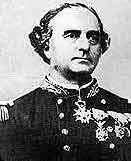 By 1874 the du Temples had constructed a large finely-built
monoplane, at Brest, France, with a wing span of some 40 feet
and a weight (minus the operator) of only about 160 pounds. At
least one attempt to actually fly the machine was made and it
is generally agreed that after gaining speed down an incline,
the flying machine lifted off for a short time and then returned
to the ground, with both machine and operator uninjured.
By 1874 the du Temples had constructed a large finely-built
monoplane, at Brest, France, with a wing span of some 40 feet
and a weight (minus the operator) of only about 160 pounds. At
least one attempt to actually fly the machine was made and it
is generally agreed that after gaining speed down an incline,
the flying machine lifted off for a short time and then returned
to the ground, with both machine and operator uninjured.
The car was to be shaped like a boat, lightly constructed of wood
or iron ribs, and might be covered on the outside with tarred
or rubber cloth. Beneath it were to be hinged three hollow legs,
which might either be folded up or allowed to hang down. Strong
springs inside of them were to carry rods or feet, at the outer
end of which were to be wheels to roll over the ground. These
legs were to be so adjusted in length that the apparatus should
present an angle of incidence of about 20 to the horizon, and
upon being put into forward motion, at the rate of about 20 miles
per hour, by the screw, it was expected to rise upon the air and
to enter upon its flight, the latter being regulated by the horizontal
tail and by the vertical rudder.
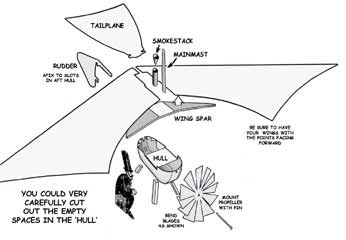 The motor might be steam, electricity, or some other prime
mover, and it was estimated that 6 H.P. would be required for
en apparatus; weighing one ton. This was a very great underestimate,
for the proposed plan of driving the machine over the ground by
means of the aerial screw would largely increase the resistance,
and sufficient speed could not be obtained to rise upon the air.
The motor might be steam, electricity, or some other prime
mover, and it was estimated that 6 H.P. would be required for
en apparatus; weighing one ton. This was a very great underestimate,
for the proposed plan of driving the machine over the ground by
means of the aerial screw would largely increase the resistance,
and sufficient speed could not be obtained to rise upon the air.
M. Du Temple tried many experiments with models shaped like birds, and his patent indicates that he had carefully considered the question of stability, for he places the majority of the weight toward the front of the car, provides for a dihedral angle during flight, and produces a slight turning up of the rear edge by making it flexible. There was a weak point, however, all the flexibility of the wings and tail caused a need for a shift of center of gravity, however Du Temple did not allow for this.
When he began with the aid of his brother, M. Louis du Temple, to experiment on a large scale, the inadequacy of all motors then known became apparent. They first tried steam at very high pressures, then a hot-air engine, and finally built and patented a very light steam boiler weighing from 39 to 44 lbs to the horse power. It consisted in a series of very thin tubes less than 1/8 in. in internal diameter, through which water circulated very rapidly, and was flashed into steam by the surrounding flame.
This is understood to have been applied to a slightly modified form of the main apparatus, built in 1874 at Brest by M. Du Temple. This was calculated to carry a man, was 40 ft. across from tip to tip, weighed about 160 lbs, and cost upward of $6,000, the workmanship being very fine.
